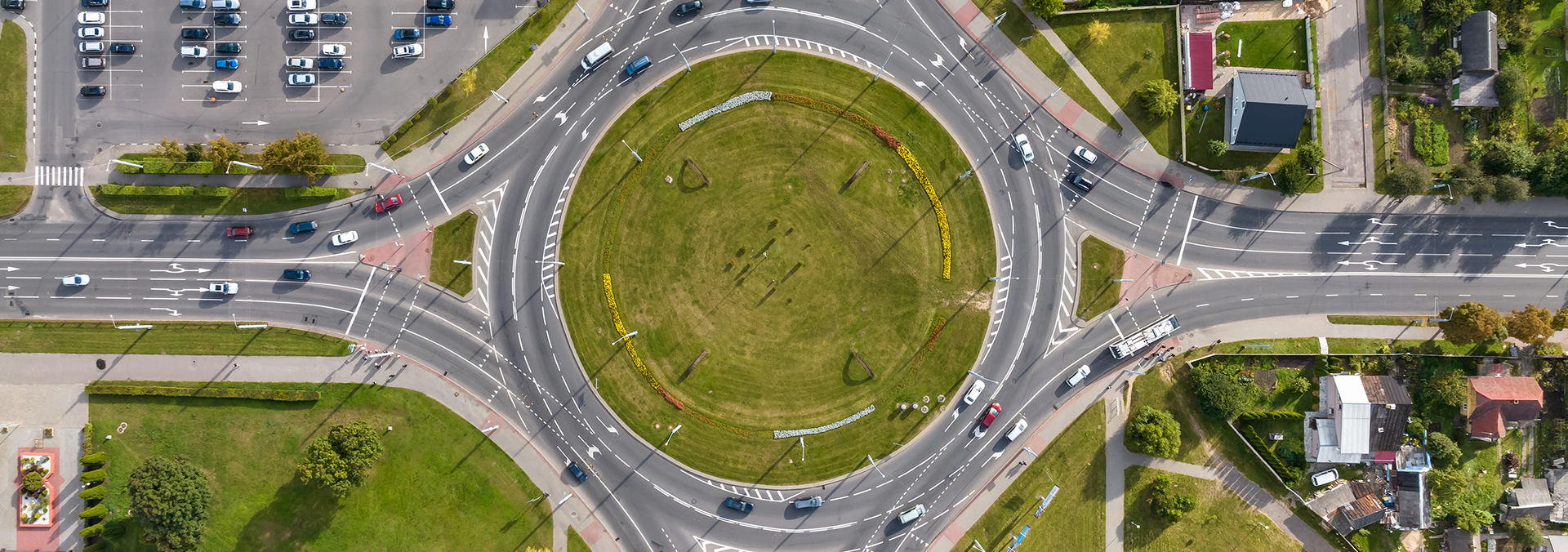
Safe Tips for Driving in Texas — Using Roundabouts
Rules of the Roundabout
Roundabouts are a type of circular intersection that have been a part of the U.S. transportation system since at least 1905. As many local residents of Pflugerville and Round Rock know, these types of intersections have been introduced to our cities. To know how to properly use a roundabout, it is important to know the rules that govern them.
There are three characteristics and design features to know about roundabouts:
- The vehicle approaching yields to the circulating traffic;
- There is a counterclockwise circulation of traffic around a central island; and
- The roundabout’s purpose is to induce slow and consistent speeds through the intersection.
These three elements require entering vehicles to wait for gaps in the circulating traffic flow to prevent the intersection from locking up. In a horizontal circular path, vehicle entry and exit speeds are reduced, which reduces crash severity. Even though roundabouts are designed to decrease traffic injuries and accidents, they still occur. There are three reasons why this is: disregarding yields, braking while in the circular intersection, and mid-circle lane changes.

Round and Round We Go
Despite the demonstrated safety design of these intersections, some crashes still occur. An IIHS study of crashes at thirty-eight roundabouts in Maryland found that four crash types — run-off-road, rear-end, sideswipe, and entering-circulating — accounted for almost all crashes. Another common crash type involved a vehicle colliding with the central island. These crashes, which often involved unsafe speeds, accounted for almost half of all single-vehicle run-off-road crashes. Some drivers may not have seen the roundabout in time to slow down sufficiently. A review of crashes at thirty-nine roundabouts in the United States found that entering-circulating, exiting-circulating and rear-end collisions were the most common crash types. While a large majority of crashes at the single-lane ones were entering-circulating crashes. At the multi-lane ones, the majority of crashes were exiting and circulating.

If used correctly, crash statistics show that roundabouts reduce fatal crashes by about 90%, reduce injury crashes by about 75%, and reduce overly crashes by about 35% when compared to other types of intersection control. These circular intersections are one of twenty evidence-based safety countermeasures recommended by the Federal Highway Administration. Some states, such as New York and Virginia, have adopted “roundabout first” policies requiring that the circular structure be considered a preferred alternative when building new intersections or upgrading older ones if feasible. These structures are not just making an appearance in the U.S., they are becoming popular all over the world. Studies of intersections in Europe and Australia that were converted to roundabouts have reported 25-87% reductions in injury crashes and 36-61% reductions in all crashes.

Multilane Roundabouts
Multilane roundabouts are more challenging. A study of a pair of the two-lane intersections near Bellingham, Washington, found that confusion about some aspects of navigating the roundabouts persisted one year after the construction ended. More than 40% of drivers said it was not clear from signs and pavement markings what speed to drive, which lane has the right of way when exiting or that they should not drive next to large trucks in the roundabouts. If you come to one of these multi-lane intersections you treat it fairly similar to a normal one. Here are some general rules to follow if you encounter one with two lanes: if you are turning right (first exit), take the outside lane. If you are going straight or the second exit, take the outside lane. If you are taking a further exit, take the innermost lane and move over before your exit, after the first or second exit.
If you find yourself approaching one of these circular intersections, it is important to slow down, the roundabout is designed for traffic not to come to a complete stop (i.e., there is no need to stop). If you find yourself approaching a busy intersection, give way to the person who is already in the circular flow. The most important rule of these structures is that you give way to vehicles that are already occupying it. Sometimes two or more vehicles might approach the roundabout at the same time. When that happens, you must give way to the vehicle to the left, which is completely opposite compared to a four-way stop, otherwise it is first come first serve.
No matter what the roundabout looks like, you can always be safe if you follow the golden rule. Yield when you enter to circulating traffic. An approaching motorist must wait for a safe gap in the flow of traffic in both lanes before entering. So, if you find yourself approaching a roundabout, just remember to yield.
Disclaimer:
This is not intended as legal advice from Dustin Fox. No attorney/client relationship has been created by this blog post. I do not represent you in any capacity unless specifically agreed to in a separate writing.
1 A Systematic Review of the Link Between Autism Spectrum Disorder and Acetaminophen: A Mystery to Resolve, interpreting data from Parker SE, Collett BR, Werler MM: Maternal acetaminophen use during pregnancy and childhood behavioural problems: Discrepancies between mother- and teacher-reported outcomes. Paediatr Perinat Epidemiol. 2020, 34:299-308. 10.1111/ppe.12601).
2 Paracetamol use during pregnancy—a call for precautionary action, Bauer, A.Z., Swan, S.H., Kriebel, D., Liew, Z., Taylor, H.S., Bornehag, C.G., Andrade, A.M., Olsen, J., Jensen, R.H., Mitchell, R.T. and Skakkebaek, N.E., 2021. Nature Reviews Endocrinology, 17(12), pp.757-766.
3 A Systematic Review of the Link Between Autism Spectrum Disorder and Acetaminophen: A Mystery to Resolve, interpreting data from Parker SE, Collett BR, Werler MM: Maternal acetaminophen use during pregnancy and childhood behavioural problems: Discrepancies between mother- and teacher-reported outcomes. Paediatr Perinat Epidemiol. 2020, 34:299-308. 10.1111/ppe.12601).
4 Paracetamol use during pregnancy—a call for precautionary action, Bauer, A.Z., Swan, S.H., Kriebel, D., Liew, Z., Taylor, H.S., Bornehag, C.G., Andrade, A.M., Olsen, J., Jensen, R.H., Mitchell, R.T. and Skakkebaek, N.E., 2021. Nature Reviews Endocrinology, 17(12), pp.757-766.
